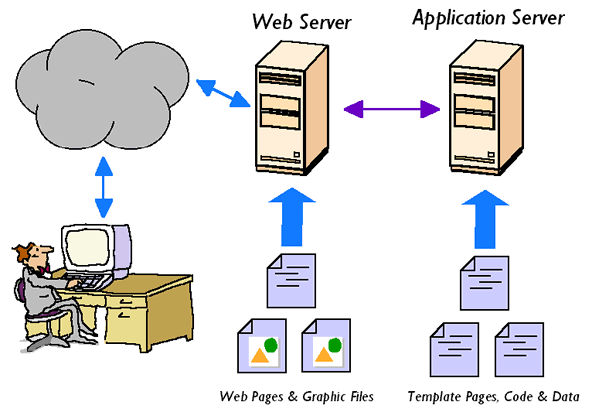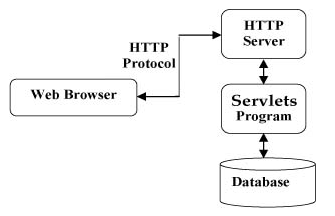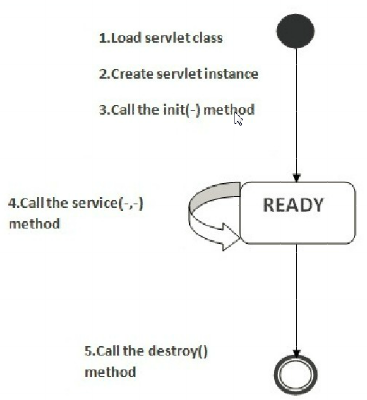Web - Servlet
Project Folder Structure
myWebApp/
WEB-INF/
web.xml
weblogic.xml
lib/
MyLib.jar
classes/
MyPackage/
MyServlet.class
jsp/
scripts/
Server

Web Server
A Web server exclusively handles HTTP requests. 主要负责收发Web请求,做一些简单的处理逻辑,复杂的逻辑转发给Application Server。
Java Web Server
- Tomcat
- httpd
Application Server
An application server serves business logic to application programs through any number of protocols. 主要负责复杂的business逻辑处理。
Java App Server
- JBoss
- Glassfish
- WebSphere
- WebLogic
Servlets
Servlet is a small Java program that runs within a web server.
- Servlets receive and respond to requests from Web clients, usually across HTTP

Servlet Life Cycle
很简单:初始化->工作中->销毁
- initialization ->
init()- The container initializes the servlet and executes all the statements from this method(Connecting to DB, initializing some objects, etc)
- servicing ->
service()- Accepting http request, precessing and sending the http response to the browser
- destroying ->
destroy()- Unload from container

Servlet Thread Safe Issue
Servlet的生命周期是由Web容器控制的,而Web容器一般会创造一个线程池,new多个Servlet。有request就从池子里拿Servlet出来处理。
- 同一时间,一个Servlet只能处理一个request。
- 处理完了之后,Servlet不会销毁/重新初始化,而是接着处理后续的request。
所以,如果代码写的不好,是有可能发生线程安全问题的。
-> 参考 servlet线程安全问题的详解 https://blog.csdn.net/after_you/article/details/54173012
Java Class Structure
javax.servlet
|
Servlet - Super interface for Java Servlet API
ServletContext - Provides runtime env for servlet
ServletConfig - Provides info about parameters
ServletRequest - super interface for all the requset objects
ServletResponse - super interface for all the response objects
GenericServlet - Non-http based servlets creation
javax.servlet.http
|
HttpServletRequest
- setAttribute()
- getAttribute()
- getSession()
- getParameter()
- getParameterValues()
- getInitParameter()
- getInitParameterNames()
HttpServletReponse
- setContentType()
- sendRedirect()
HttpServlet (class)
- public void init()
- public void service(HttpServletRequest, HttpServletResponse)
- public void destroy()
- public void doGet(HttpServletRequest, HttpServletResponse)
- public void doPost(HttpServletRequest, HttpServletResponse)
HttpSession
- setAttribute()
- getAttribute()
- getId()
- getLastAccessedTime()
Cookie
Example
// Import required java libraries
import java.io.*;
import javax.servlet.*;
import javax.servlet.http.*;
// Extend HttpServlet class
public class HelloWorld extends HttpServlet {
private String message;
public void init() throws ServletException {
// Do required initialization
message = "Hello World";
}
public void doGet(HttpServletRequest request, HttpServletResponse response)
throws ServletException, IOException {
// Set response content type
response.setContentType("text/html");
// Actual logic goes here.
PrintWriter out = response.getWriter();
out.println("<h1>" + message + "</h1>");
}
public void destroy() {
// do nothing.
}
}
Quick Run Servlets in Tomcat
简单版本的,就是把classpath设好,把class文件放好,把xml改好,然后就可以run了。
Set the classpath for servlet.jar from tomcat folder
set classpath=%classpath%; ...\tomcatXXX\lib\servlet.jar;
Copy the servlet .class file to the tomcat server folder
tomcat-XXX\webapps\ROOT\WEB-INF\classes
Register the servlet in web.xml
<servlet>
<servlet-name>HelloServlet</servlet-name>
<servlet-class>HelloServlet</servlet-class>
</servlet>
<servlet-mapping>
<servlet-name>HelloServlet</servlet-name>
<url-pattern>/HelloServlet</url-pattern>
</servlet-mapping>
Start the tomcat in cmd
- tomcat\bin >
catalina.bat run
Open the browser and visit the URL
http://localhost:8080/HelloServlet
Session
How to Share Data Between Multiple Requests
用户的发来多个请求,服务器应该有一个上下文Context的概念。这其实就是 “会话” Session 的功能。
- HttpSession
javax.servlet.http.HttpSession session = request.getSession(true);Product product = (Product) session.getAttribute("myproduct");
- URL parameters(不常用)
- Cookies(不常用)
Cookies v.s. Session
- Sessions are server-side files that contain user information, while Cookies are client-side files that contain user information.
- Sessions have a unique identifier that maps them to specific users. This identifier can be passed in the URL or saved into a session cookie.
http://stackoverflow.com/questions/359434/differences-between-cookies-and-sessions
